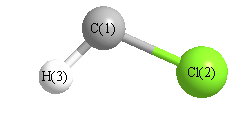Jump to
S2C1
Energy calculated at CCSD=FULL/aug-cc-pVDZ
| | hartrees |
|---|
| Energy at 0K | -498.134420 |
| Energy at 298.15K | -498.134282 |
| HF Energy | -497.832210 |
| Nuclear repulsion energy | 38.180797 |
The energy at 298.15K was derived from the energy at 0K
and an integrated heat capacity that used the calculated vibrational frequencies.
Geometric Data calculated at CCSD=FULL/aug-cc-pVDZ
Point Group is Cs
Cartesians (Å)
| Atom |
x (Å) |
y (Å) |
z (Å) |
|---|
| C1 |
0.046 |
1.211 |
0.000 |
| Cl2 |
0.046 |
-0.512 |
0.000 |
| H3 |
-1.054 |
1.438 |
0.000 |
Atom - Atom Distances (Å)
| |
C1 |
Cl2 |
H3 |
| C1 | | 1.7226 | 1.1232 |
Cl2 | 1.7226 | | 2.2384 | H3 | 1.1232 | 2.2384 | |
 More geometry information
More geometry information
Calculated Bond Angles
| atom1 |
atom2 |
atom3 |
angle |
|
atom1 |
atom2 |
atom3 |
angle |
| Cl2 |
C1 |
H3 |
101.652 |
|
Electronic energy levels
Charges, Dipole, Quadrupole and Polarizability
Jump to
S1C1
Energy calculated at CCSD=FULL/aug-cc-pVDZ
| | hartrees |
|---|
| Energy at 0K | -498.128409 |
| Energy at 298.15K | -498.128259 |
| HF Energy | -497.855238 |
| Nuclear repulsion energy | 38.444119 |
The energy at 298.15K was derived from the energy at 0K
and an integrated heat capacity that used the calculated vibrational frequencies.
Geometric Data calculated at CCSD=FULL/aug-cc-pVDZ
Point Group is Cs
Cartesians (Å)
| Atom |
x (Å) |
y (Å) |
z (Å) |
|---|
| C1 |
0.037 |
1.170 |
0.000 |
| Cl2 |
0.037 |
-0.520 |
0.000 |
| H3 |
-0.850 |
1.812 |
0.000 |
Atom - Atom Distances (Å)
| |
C1 |
Cl2 |
H3 |
| C1 | | 1.6899 | 1.0952 |
Cl2 | 1.6899 | | 2.4951 | H3 | 1.0952 | 2.4951 | |
 More geometry information
More geometry information
Calculated Bond Angles
| atom1 |
atom2 |
atom3 |
angle |
|
atom1 |
atom2 |
atom3 |
angle |
| Cl2 |
C1 |
H3 |
125.891 |
|
Electronic energy levels
Charges, Dipole, Quadrupole and Polarizability
